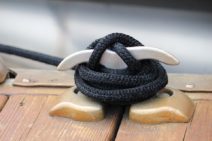
They say that first impressions are everything in negotiation, but first offers can be just as important. According to the anchoring bias, documented by psychologists Amos Tversky and Daniel Kahneman, the initial offer made in a negotiation—however arbitrary it may be—serves as an “anchor” that pulls the discussion in its direction.
One question that research on the anchoring bias didn’t address until recently is whether your anchor should be a single figure or a range offer. Imagine, for instance, that you’re about to negotiate the price of your used car with a potential buyer. The car’s fair market value is about $5,000–$6,000, your research shows. Should your aggressive first offer be a specific price—say, $7,000—or a price range, such as “I could sell the car to you for about $6,500 to $7,500”?
In a 2015 study in the Journal of Personality and Social Psychology, Columbia University professors Daniel R. Ames and Malia F. Mason find that expressing offers in a range can be a wise move in distributive negotiation, thanks to the anchoring bias.
What Type of Range?
Ames and Mason have identified three different types of ranges that negotiators tend to use when making price offers in distributive bargaining, varying from the unambitious to the bold:
- Bolstering range: A bolstering range includes the single-figure offer at one end and a more ambitious number at the other end, such as a seller asking $7,000–$7,500 rather than $7,000 for her car.
- Backdown range: A backdown range features the single-figure offer at one end and a less ambitious figure at the other end, such as the same seller asking $6,500–$7,000 for her car instead of $7,000.
- Bracketing range: A bracketing range spans the single-figure offer, such as an offer of $6,800–$7,200 rather than $7,000 for the same car.
In a pilot study, Ames and Mason asked nearly 400 U.S. participants to imagine that they were the seller in a used-car negotiation and to come up with both a single-figure offer and a range offer for the car. Among the participants, 51% constructed bracketing-range offers, 29% constructed backdown-range offers, and only 17% constructed bolstering-range offers. Research on the anchoring bias suggests why range offers may often be ineffective: If most people construct unambitious ranges, it’s not surprising their offers would lead to disappointing outcomes.
The Benefits of Bolstering Ranges
By contrast, Ames and Mason found across five experiments that bolstering ranges—those that aggressively stretch the bounds of a single-figure offer—can be highly effective in price-haggling negotiations, thanks to the anchoring bias.
In one online experiment, participants were assigned the role of either buyer or seller of a used car. Those playing the seller were randomly asked to make one of several types of opening offers, including a single-figure offer, a bracketing-range offer, or a bolstering-range offer.
The pairs then engaged in an online negotiation simulation. The results showed that buyers who received bolstering-range offers made greater concessions and more conciliatory counteroffers than did buyers who received the other types of offers. Why? Because they assumed that their sellers had more ambitious bottom lines, or reservation prices.
In addition, buyers faced with bolstering-range offers were more concerned than buyers who received a single-figure offer that their counterpart would perceive them as impolite if they made an assertive counteroffer. The researchers theorized that a range offer signals greater flexibility than a single-price offer. Consequently, recipients of range offers may prefer to counter within the suggested range.
Bolstering Offers to Your Advantage
Those who make bolstering-range offers also seem to avoid the reputational damage that often accompanies aggressive offers that capitalize on the anchoring bias, Ames and Mason found. Because ranges appear to convey flexibility and accommodation, they may offset the assertiveness conveyed by asking for more.
There are limitations to the effectiveness of bolstering-range offers. First, very wide ranges (such as $6,000–$9,000 for a used car valued at $6,000 as compared with $6,000–$7,000) did not yield significant gains; ranges of about 5% to 20% of the base figure appear to work best. In addition, bolstering ranges that started with an extreme value and extended to an even more aggressive figure (such as $8,000–$9,000 rather than $7,000–$8,000 for that used car) also were not beneficial.
In sum, Ames and Mason’s research suggests another way to improve your negotiation skills with the help of the anchoring bias: by crafting a bolstering range, you should be able to claim more value while preserving a strong relationship with your counterpart.
Have you used the anchoring bias to your advantage in negotiation, and if so, how?




